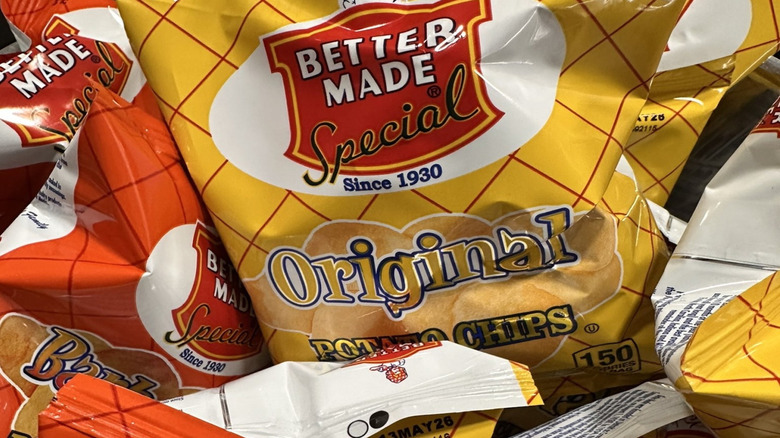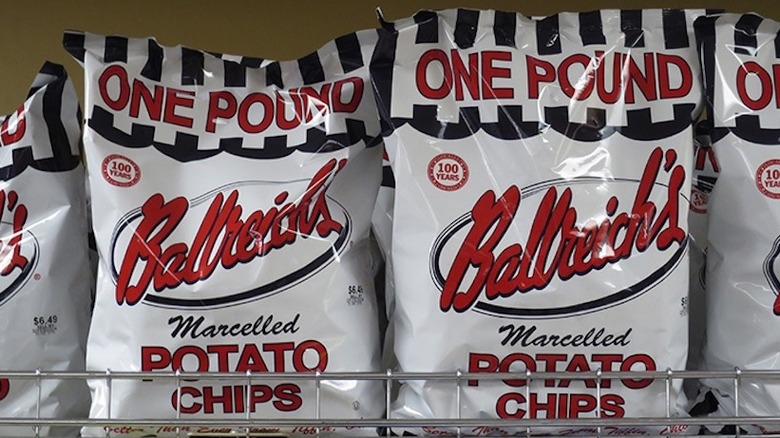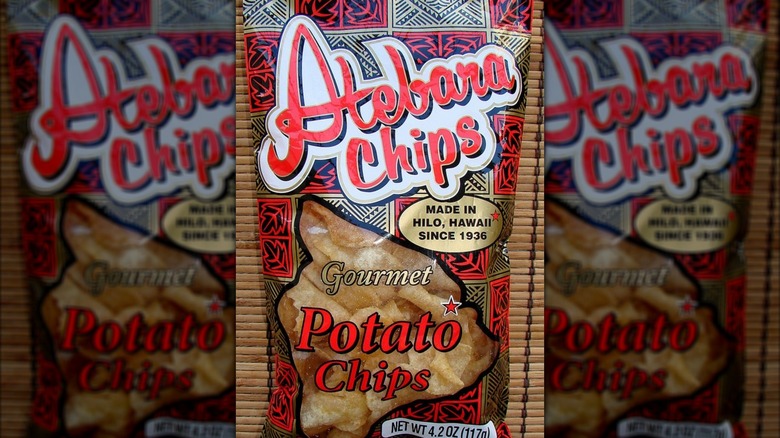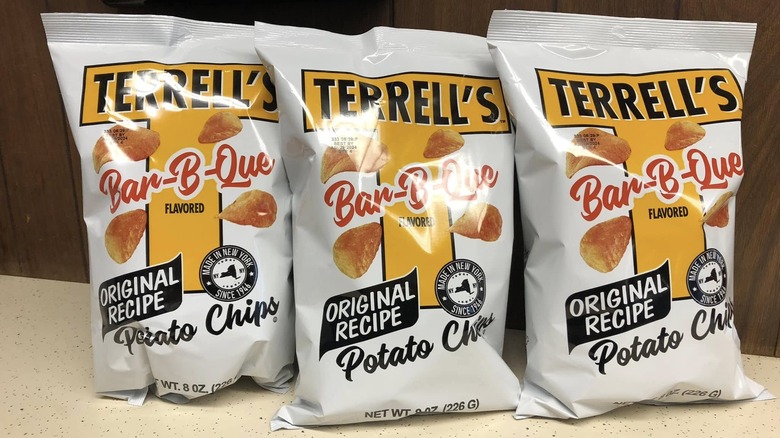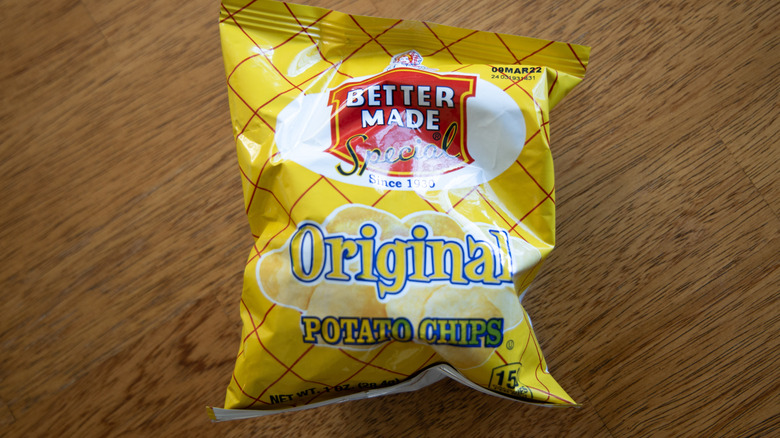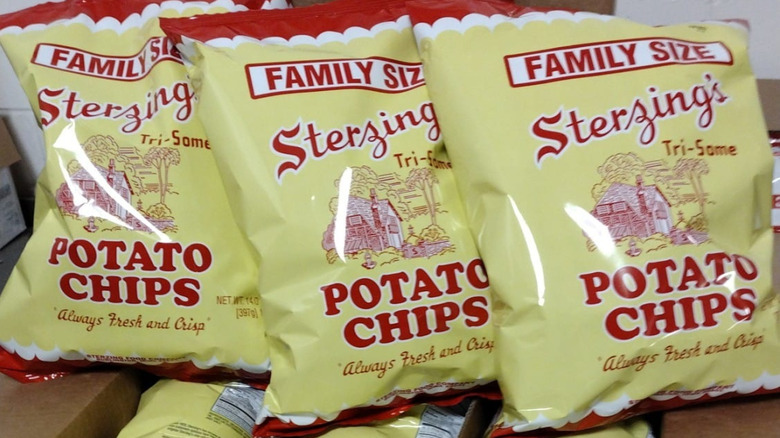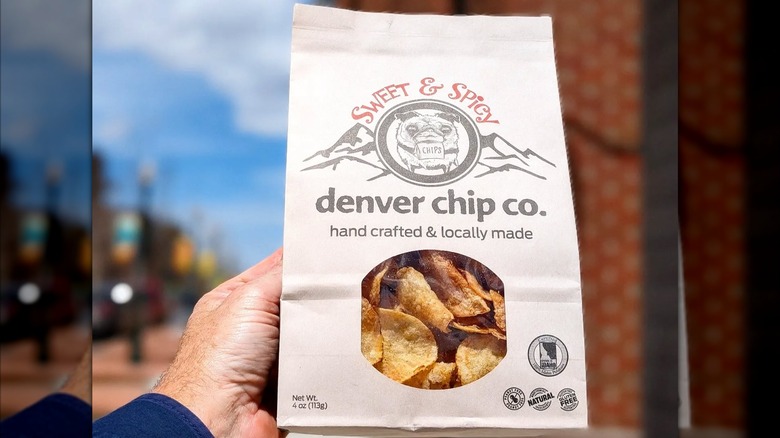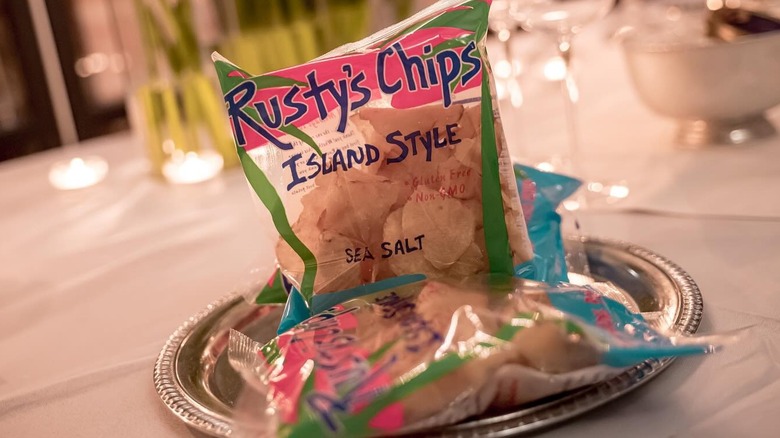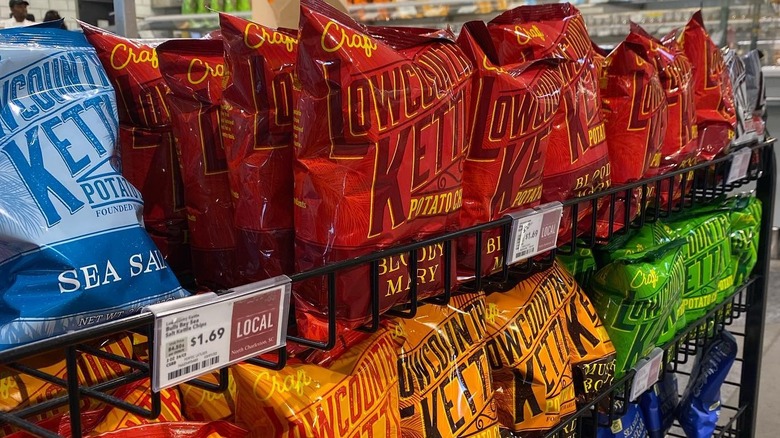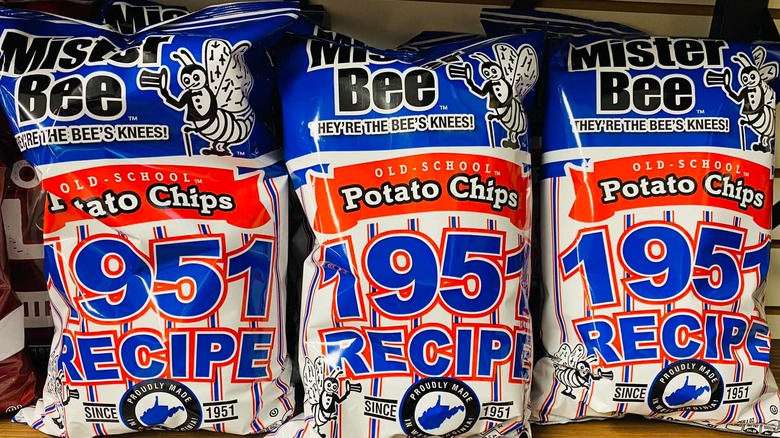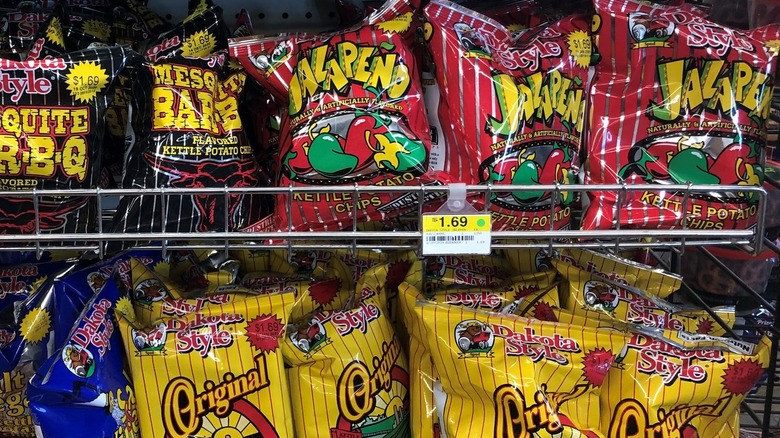Regional Potato Chip Brands You Need To Try
At the beginning of the long and tasty history of potato chips, the classic snack and sandwich sidekick caught on as a regional product. The longer chips have to travel and sit around, staleness and breakage become concerns. While large companies eventually set up factories and distribution centers around the country (and the world), they couldn't fully eliminate the well-entrenched local competitors that had given people their starchy, salty snacks for as long as a century or more, predating those national distribution networks. The very best plain potato chips and plenty of other varieties are still manufactured by regional companies. They're just that good, largely because they're made in smaller batches and don't have to be trucked very far.
In a food retail landscape dominated by national brands, potato chips remain a regional game. It may be time to take a road trip and track down some of the smaller, local, and lesser-known potato chip companies that make the best snacks and deserve the same widespread recognition as the bigger names.
Ballreich's
The history and rise of the kettle chip took a stop in an unfinished garage in Tiffin, Ohio, in 1920. Fred and Ethel Ballreich developed a method of frying potato chips in a big copper kettle fueled by scraps of wood. Ballreich's product was a hit, not just for its unique taste and preparation, but for its shape. These chips were marcelled, or wavy, among the first of their kind, with the Ballreichs taking inspiration from the faddish wavy hairstyle of the time.
The company kept expanding over the decades, moving into larger and more sophisticated production facilities to meet the demand for its wavy chips, sold predominantly in Ohio. In the 1990s, Ballreich's made its first major steps into new flavors, but just like the presentation of its original chips, the brand kept its new additions unique. Ballreich's morsels come in flavors not seen in its corner of the Midwest or many other places, for that matter. Some of its most innovative offerings include Honey Butter, Heidelberg Siggy Sauce (designed by a local restaurant and combining sriracha and honey butter), Chili Cheese Dog, Dry Rub, and Ghost Pepper.
Atebara's
Raymond Atebara began his eponymous chip company in 1936 in Hilo. At first, the company only served Hawaii's main island before expanding and distributing to the rest of the archipelago. World War II-era potato rationing forced Atebara's to make up the difference with taro root chips, a native Hawaiian plant that figures prominently into local cuisine. This marked the first time that taro root chips had been produced commercially for the Hawaiian market, and it's a big reason why the company became the top local potato chip brand, a title held ever since. Today, Atebara's original, taro, and sweet potato chips are produced via a handmade process, sourced from as many as 15 family-owned farms around Hawaii.
Atebara's has expanded its offerings to meet unique regional tastes, including purple sweet potato and shrimp chips, as well as flavors like Korean BBQ and Adobo. The brand also has a gourmet line of chocolates and candies.
Terrell's Potato Chips
Up until the 1980s, New York was one of the major potato farming states, and the U.S. Northeast hosted a bustling potato chip industry throughout the 20th century. One notable player was Terrell's Potato Chips. William Terrell used New York-grown potatoes to make thinly sliced chips and fried the pieces in oil in small batches. Three generations later, it's still a family-run business, and very little has changed: The company continues to use locally sourced ingredients and Terrell's same recipe from 1946.
Terrell's Potato Chips are technically available at hundreds of locations, but that's just because it responded to the insatiable customer demand built up over 80 years in its hometown of Syracuse, New York, and into nearby areas like Massachusetts, Vermont, and Pennsylvania (the state that makes the most potato chips). Although it has been around for decades and occasionally introduces new flavors, Terrell's mainly keeps it simple. The company's staple offerings include: Original, Ripple, Bar-B-Que, and the proprietary and ultra-localized Syracuse style, purportedly a combination of seasoning blends like salt and vinegar, barbecue, and spices.
Better Made
Once one of America's most booming economic hotspots and population centers due to the presence of multiple automakers, Detroit developed many preferred homegrown brands and tastes that national companies couldn't dislodge. While we all love Detroit-style pizza now, other Motor City favorites never entered the wider consciousness. The regional potato chip most synonymous with Detroit, for example, is Better Made.
Founded by Sicilian immigrants in the 1930s, the chippery that would become Better Made built its name with a decidedly unpretentious style that really showed off the personal nature of the chips. Workers hand-filled wax paper bags and stapled them shut before distributing them at stands in Belle Isle Park and selling door-to-door. Better Made only began making flavored chips in the 1970s, with Barbecue and Sour Cream and Onion so well-received that they became instant classics. In the mid-20th century, over 20 companies manufactured chips in Detroit, and Better Made is the only one to last to the present day. Despite a massive chip-making operation, the brand's snacks are seldom seen outside of Michigan and the upper Midwest.
Tri-Sum
One of the earliest major potato chip companies in the United States (Lay's didn't get started until 1932), Tri-Sum began as a minuscule operation in 1908 by entrepreneur J.P. Duchesneau. Every step of the process was done by hand, and he'd deliver packages of the salty snack to contracted vendors on an 8-mile route in the neighboring Massachusetts towns of Leominster and Fitchburg via the use of a horse-drawn carriage. Once the Leominster Potato Chip Company, business got a much-needed boost in the 1930s from a playful name change: The winning entry in a factory workers' contest was Tri-Sum, as in "try some" of our wonderful potato chips.
Now run by a fifth generation of members of the Duchesneau family, Tri-Sum chips are distributed throughout New England, outlasting more than 80 other area potato chip companies due to encroachment and pressure from national brands in the late 20th century. Tri-Sum still keeps things simple, producing just a handful of thin-cut varieties that have been perfected over the decades. The only available flavors are Original, Sour Cream and Onion, and Honey Barbecue.
Charles Chips
Most Americans get their potato chips in one particular way: They go to a store and buy them in a shiny, airtight metallic-plastic bag. However, in the 1940s and 1950s, residents in Pennsylvania and surrounding areas, as well as South Florida, associated chips with vans and cans. Once sold at farmers markets, Charles Chips utilized a fleet of vehicles to deliver the product to both businesses and homes, and they came in canisters of various sizes. One could tell they were fresh off the production line, too, because the chips were attractively, deliciously, and visibly oily.
A form of novelty marketing, the cans disappeared by the 1990s, but new owners brought them back in the 21st century, relaunching Charles Chips as a specialty, high-quality alternative to big-name brands, made with the same recipes used in the 1930s. They're sold in bags or tins of several flavors, but there's just something special about a giant can of thin and crispy potato chips.
Tim's Cascade Style
Tim Kennedy saw an opening in the potato chip market in the mid-1980s. He found most brands' products were too thin and uninteresting, so he started Tim's Cascade Snacks to make the crunchy bites with a lot more flavor and thickness. From a factory outside Seattle, Kennedy and company initially made two flavors: Original and Jalapeño.
Lacking any money for marketing, the brand offered the chips free at community events and stores. Eventually, consumers around the Pacific Northwest embraced Tim's Cascade Style chips. The snacks even went up on the shelves of Costco locations in Japan, where the jalapeño flavor and a spinoff called Hawaiian Sweet Maui Onion Ships were a blockbuster. Its imprint in the West only grew with the introduction of innovative flavors like Hawaiian Teriyaki, Vlasic Dill Pickle, Wasabi, and Creamy Cucumber. While the brand regularly offers special flavors, Johnny's Seasoned Potato Chips are a regional favorite.
Sterzing's Potato Chips
In 2015, Sterzing's Potato Chips faced a crisis the likes of which it had never seen. The makers of the top-selling chip in the southeastern corner of Iowa had to change the recipe they had used since 1935 to adhere to a government ban on the use of markedly unhealthy trans fats in processed foods. The chips had been so popular among generations of Iowans because of their simplicity: potatoes, salt, and soybean oil. After several years of experimentation, Sterzing's and its staff of only about 20 people saved the brand when they devised a new way of making the chips by switching to thick, luxurious, 100% beef tallow.
Other than the change in cooking oil, Sterzing's Potato Chips are prepared in much the same way that Barney Sterzing employed in the 1930s. Potatoes are sliced and fried in small, individual batches, then packed and shipped out daily.
Mrs. Fisher's
The "Mrs. Fisher" behind Mrs. Fisher's Potato Chips is a real person — Ethel Fisher started cooking the snacks at her home in Rockford, Illinois, during the Great Depression. In addition to regular, full-sized bags of intact chips, Fisher managed to make money during that catastrophic economic downturn with the sale of "Penny Chips": little paper bags full of crumbs and broken bits. For years, Fisher worked mostly alone, peeling, slicing, and frying 100 pounds of potatoes every day.
Today, the Rockford-based operation is much more robust: 50,000 pounds of potatoes are thickly chipped each week. That's a massive amount of product to serve a geographically small but very loyal fanbase. Bags of Mrs. Fisher's Chips, still bearing the same logo designed by the founder's husband in 1932, are sold along a 25-mile delivery route surrounding Rockford, while other distributors transport the snacks slightly farther away. Mrs. Fisher's is a regional delicacy, serving customers in Wisconsin, Chicago, and Joliet, Illinois.
Broad Ripple Chip Co. and Denver Chip Co.
Two related companies situated thousands of miles apart in Indiana and Colorado produce some of the most locally-loved chips in the whole country. Broad Ripple Chip Co., which operates outside of Indianapolis, carefully crafts its chips using only russet potatoes. The company claims this variety gives the product a deeper flavor and color as opposed to other chip brands that may use cheaper and less flavorful white potatoes. Broad Ripple also seasons its flagship original chips with just a little bit of salt, preferring to make a snack that tastes strongly of potatoes as well as the healthier canola oil it uses for frying. The chips are delivered fresh to area businesses because no preservatives are used.
Over in the Rocky Mountains, the sons of Broad Ripple's owner set up shop in Lakewood, Colorado. Denver Chip Co. makes almost the same chips as the Indiana-based location, just using a satellite office to bring its richly potato-tasting chips to a different market. The brand offers an original flavor with hints of onion and garlic, along with a Sweet & Spicy variety.
Rusty's Chips
Back in 1980, a guy from California named Rusty decided that he wanted to sell Hawaiian-style potato chips in the contiguous United States. So, he started Rusty's Chips. The company uses potatoes brought in from Bakersfield, and they're sliced one at a time using a hand slicer and cooked in safflower oil, one of the more expensive cooking fats. Then they're dried and salted with an equally special ingredient: Mediterranean sea salt. Rusty's Chips has kept up this method since its founding, with a moderately small staff at a facility in Huntington Beach. The bags are filled and weighed by hand, too, as they're placed into transparent plastic bags.
Initially, Rusty sold his chips in a decidedly low-key and intentionally small way: by the bag at a Southern California farmers market. The brand has since made its way into over 300 locations throughout California. Chips are available in six different flavors, including the original Sea Salt, Black Pepper, and the Chili Lime Island Style. Along with the corn-based Surf City Strips, there's also Bacon Up chips: a partnership with Bacon Up packaged bacon grease. When added during the frying stage, it imparts an authentic bacon taste. Rusty's was acquired in 2024 by Longport Beach-based firm Cooper Brands, which could signify more widespread distribution. For now, however, the chips are a California specialty.
Lowcountry Kettle Chips
The Lowcountry Kettle Potato Chips brand was created expressly with the goal of being a regional favorite snack. Culinary school grad and Charleston, South Carolina, restaurant manager Andrew Trumbull wanted to sell locally made chips in his establishment's downstairs gelateria, but couldn't find any options inside the state. So, along with another business owner, Trumbull started making Lowcountry Kettle Potato Chips.
To stand out from the major chip companies' products and to emphasize the regionality of the snack, Lowcountry Kettle Chips aims to make its thick-cut, oil-fried chips available in as many flavors as possible, inspired by Southern and Carolina cuisine. To that end, it makes flavors that few or no other brands even attempt. There exist varieties including Carolina Sea Salt, Carolina Reaper, Mustard BBQ, State Fair Fried Pickle, and Spicy Pimento Cheese. For the broader market, Lowcountry Kettle Chips come in flavors such as Bloody Mary, Sea Salt, and Red Wine Vinegar & Sea Salt.
Mister Bee
What sets Mister Bee apart from other chip brands is its proud and utter lack of uniformity. Launched and sold exclusively in West Virginia in 1951, potatoes are hand-picked with flavor in mind, rather than looks, meaning that each bag of chips may feature several colors and textures. Mister Bee also doesn't peel its potatoes, adding another layer of flavor to a chip that's cooked for longer periods at lower temperatures than other brands.
Mister Bee's line of flavors — a breadth made possible by the company's introduction of continuous frying technology — features tastes not often seen outside of its Appalachian retail territory. It's got Mothman-flavored chips, spiced with an enigmatic blend inspired by the West Virginia-cryptid of the same name, as well as Pepperoni Roll chips. Every state has a signature sandwich, and this flavor is inspired by West Virginia's calzone-style sandwich that is also its state food.
Dakota Style
In 1985, Dakota Style Kettle Chips got its start in the small town of Clark, a ranching and farming area in eastern South Dakota where the brand has ample space to grow potatoes. Even 40 years later, it's a small enough operation that it can do a lot of things by hand, including precise potato selection. After they're scrubbed and cut into very thick slices, the potatoes are fried in small batches in an open kettle. That's how Dakota Style Kettle Chips gets the intimidating "industrial strength" designation printed onto every bag. These snacks are sold primarily in stores in South Dakota (and via mail order), and in just five flavors.
While the product lineup isn't gigantic, the flavors are. Different potato chip varieties include Mesquite BBQ, Salt and Vinegar, Jalapeño, Honey Mustard, and Dill Pickle. The company also sells popcorn kernels, pretzels, and sunflower seeds.
